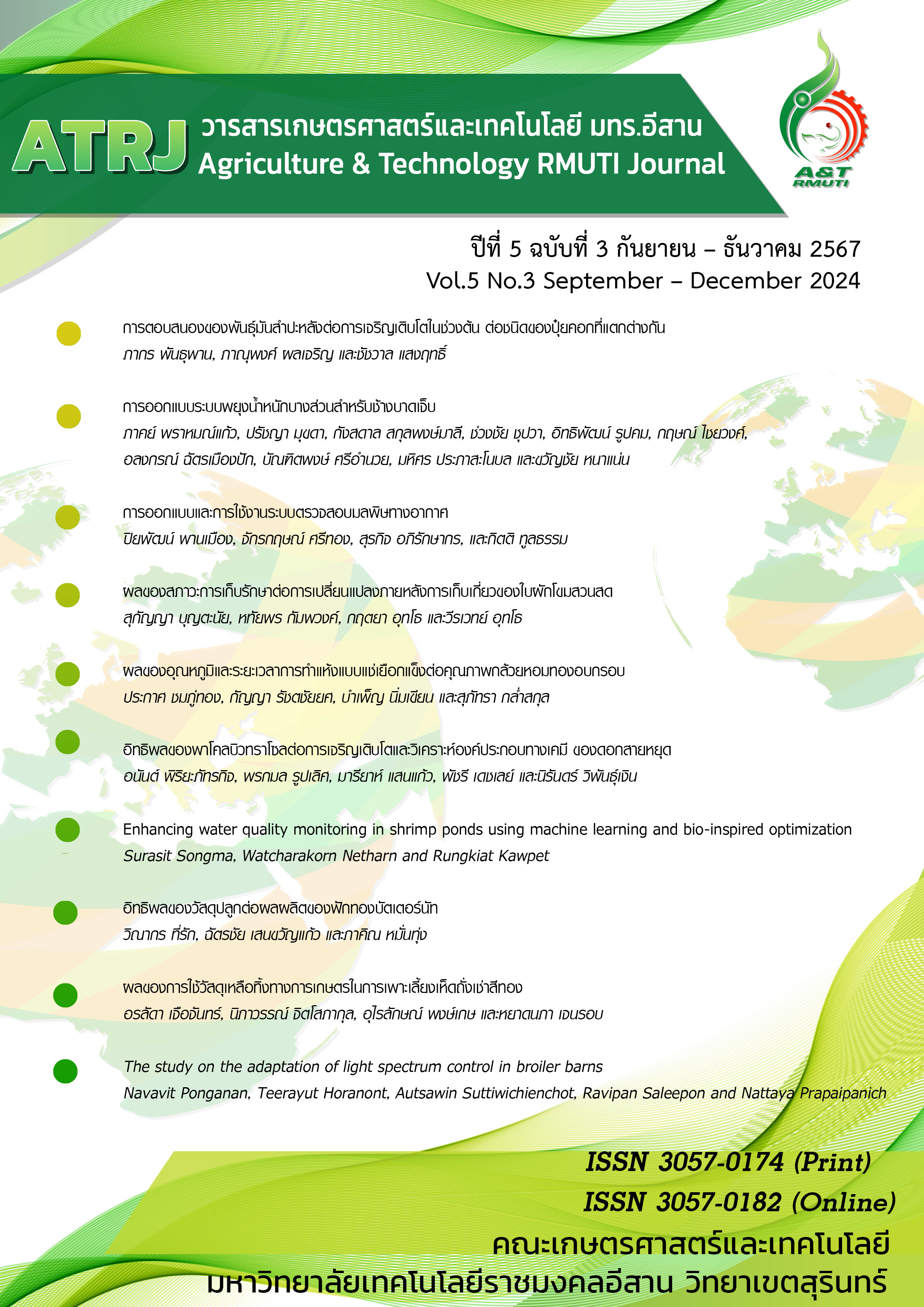ผลของสภาวะการเก็บรักษาต่อการเปลี่ยนแปลงภายหลังการเก็บเกี่ยวของใบผักโขมสวนสด
คำสำคัญ:
อัตราการหายใจ, น้ำหนักสด , ปริมาณกรดแอสคอร์บิก , ใบผักโขมสดบทคัดย่อ
ใบผักโขมสวนสดมีการเปลี่ยนแปลงคุณภาพหลังการเก็บเกี่ยวได้เร็วส่งผลให้ความสามารถทางการตลาดลดลง การวิจัยนี้มีวัตถุประสงค์เพื่อศึกษาผลของสภาวะการเก็บรักษาประกอบด้วยอุณหภูมิ (10-35°C) และเวลา (10 วัน) ต่ออัตราการหายใจ น้ำหนักสด และกรดแอสคอร์บิกภายหลังการเก็บเกี่ยวของใบผักโขมสวนสด ผลทดลอง พบว่า การเปลี่ยนแปลงหลังการเก็บเกี่ยวดังกล่าวที่อุณหภูมิ 10°C เกิดขึ้นได้ช้ากว่าเมื่อเปรียบเทียบกับอุณหภูมิ 25°C และ 35°C การเพิ่มขึ้นของอัตราการหายใจสัมพันธ์กับอุณหภูมิในลักษณะของเอกซ์โปเนนเชียล (Exponential) และทำนายได้ดีด้วยแบบจำลองคณิตศาสตร์ของอาร์รีเนียส (Arrhenius model) มีค่า R2 และ RMSE (Root Mean Square of Errors) เท่ากับ 0.98 และ 0.08 ตามลำดับ และค่า energy of activation เท่ากับ 32.65 kJ mol-1 ใบผักโขมสูญเสียน้ำหนักสดอย่างต่อเนื่องโดยเฉพาะที่ 25°C และ 35°C มีร้อยละการสูญเสียน้ำหนักสดสูงกว่า 2.50 ภายหลังเก็บรักษา 3 วัน ใบผักโขมเหี่ยวเฉาและไม่เป็นที่ยอมรับของผู้บริโภค ในทางตรงกันข้ามที่ 10°C ใบผักโขมสูญเสียน้ำหนักสดต่ำกว่าร้อยละ 3.50 และมีลักษณะปรากฏที่สดตลอดการเก็บรักษา ปริมาณกรดแอสคอร์บิกลดลงอย่างต่อเนื่องจากค่าเริ่มต้น (11.48 mg 100g-1) และเกิดขึ้นได้เร็วมากที่ 25°C และ 35°C ปริมาณกรดแอสคอร์บิกในแต่ละช่วงเวลาทำนายได้ดีด้วยแบบจำลองคณิตศาสตร์ First Order Fractional Conversion (FOFC model) มีค่า R2 และ RMSE เท่ากับ 0.99 และ 0.001-0.120 ตามลำดับ การเพิ่มขึ้นของค่าสัมประสิทธิ์ FOFC model มีความสัมพันธ์กับอุณหภูมิแบบเอกซ์โปเนนเชียลและทำนายได้ดีด้วย Arrhenius model มีค่า R2 และ RMSE เท่ากับ 0.99 และ 0.02 ตามลำดับ และมีค่า energy of activation เท่ากับ 93.10 kJ mol-1 ข้อมูลจากผลการวิจัยนี้เป็นแนวทางเพื่อวางแผนชะลอการเปลี่ยนแปลงคุณภาพของผักโขมสดในระหว่างการเก็บรักษา
References
จริงแท้ ศิริพานิช. (2550). ชีววิทยาหลังการเก็บเกี่ยวและการวายของพืช. พิมพ์ครั้งที่ 2. โรงพิมพ์ศูนย์ส่งเสริมและฝึกอบรมการเกษตรแห่งชาติ: นครปฐม.
นิธิยา รัตนาปนนท์. (2545). เคมีอาหาร. พิมพ์ครั้งที่ 2. โรงพิมพ์โอเอสพริ้นติ้งเฮ้าส์: กรุงเทพฯ.
ปนิวัตน์ ทาสา และวีรเวทย์ อุทโธ. (2559). จลนพลศาสตร์ของการเปลี่ยนแปลงของคลอโรฟิลล์เอในใบผักชีฝรั่งที่สัมพันธ์กับอุณหภูมิการเก็บรักษาและสภาวะบรรยากาศดัดแปรในบรรจุภัณฑ์. ใน การประชุมวิชาการระดับชาติ มอบ.วิจัย ครั้งที่ 10 การพัฒนาท้องถิ่นสู่ภูมิภาคอาเซียน: งานวิจัยกับอนาคตสังคมไทย 7-8 กรกฎาคม 2559. มหาวิทยาลัยอุบลราชธานี. อุบลราชธานี.
พรชัย หาระโคตร, ลลิตา เจริญทรัพย์, ภาณุมาศ ฤทธิไชย และสมพงษ์ ทะบันหาร. (2563). ผลของอุณหภูมิและระยะเวลาการเก็บรักษาต่อคุณภาพปริมาณสารต้านอนุมูลอิสระและความสามารถในการยับยั้งอนุมูลอิสระในไมโครกรีนผักขี้หูด (Raphanus sativus var. caudatus Alef). วารสารแก่นเกษตร. 48(1): 201-210.
วีรเวทย์ อุทโธ. (2562). การบรรจุภัณฑ์บรรยากาศดัดแปรแอคทีฟสำหรับผักและผลไม้สด. พิมพ์ครั้งที่ 2. โรงพิมพ์มหาวิทยาลัยอุบลราชธานี: อุบลราชธานี.
วีรเวทย์ อุทโธ, วรงค์ นัยวินิจ, เรวัติ ชัยราช, วัชรพงษ์ วัฒนกูล และอดุลย์ อภินันทร์. (2563). การหายใจและการสูญเสียน้ำหนักของมะม่วงแก้วขมิ้นที่สัมพันธ์กับอุณหภูมิในระหว่างกิจกรรมโลจีสติกส์ภายหลังการเก็บเกี่ยวของเกษตรกรรายย่อยชาวกัมพูชา. ใน การประชุมวิชาการระดับชาติ มอบ. วิจัยครั้งที่ 14 Research and Innovations for All 3-4 กันยายน 2563. มหาวิทยาลัยอุบลราชธานี. อุบลราชธานี.
ศศิมล มุ่งหมาย, วัชรพงษ์ วัฒนกูล, อดุลย์ อภินันทร์ และวีรเวทย์ อุทโธ. (2565). ผลการปล่อยไอระเหยเอทานอลในบรรจุภัณฑ์แอคทีฟต่อคุณภาพการเก็บรักษาสำหรับไชยาสด. วารสารวิทยาศาสตร์และเทคโนโลยี มหาวิทยาลัยราชภัฏบุรีรัมย์. 6(2): 33-50.
สุกัญญา บุญตะนัย, หทัยพร กัมพวงศ์, นิตยา ภูงาม, กฤตยา อุทโธ, เรวัติ ชัยราช และวีรเวทย์ อุทโธ. (2565). ผลขออุณหภูมิและระยะเวลาเก็บรักษาต่อการเปลี่ยนแปลงคุณภาพของวอเตอร์เครส. ใน การประชุมวิชาการระดับชาติ ครั้งที่ 13 วิจัยและนวัตกรรมเพื่อพัฒนาเศรษฐกิจ BCG 17-18 พฤศจิกายน 2565. มหาวิทยาลัยเทคโนโลยีราชมงคลอีสาน วิทยาเขตสุรินทร์. สุรินทร์. 498-509.
หทัยพร กัมพวงค์. (2563). การพัฒนาซองควบคุมการปล่อยไอระเหยเอทานอลด้วยการกระตุ้นโดยความชื้นเพื่อการบรรจุภัณฑ์แอคทีฟสำหรับพริกหวานสด. วิทยานิพนธ์วิทยาศาสตรมหาบัณฑิต สาขาเทคโนโลยีการอาหาร คณะเกษตรศาสตร์ มหาวิทยาลัยอุบลราชธานี.
A.O.A.C. (1990). Official methods of analysis of the Association of Official Analytical Chemists. Association of Official Analytical Chemists Inc. U.S.A. 910-930: 1045-1114.
Ávila I.M.L.B. and Silva C.L.M. (1999). Modelling kinetics of thermal degradation of color in peach puree. Journal of Food Engineering. 39(2): 161–166.
Bangar S.P., Dunno K., Dhull S.B., Siroha A.K., Changan S., Maqsood S. and Rusu A.V. (2022). Avocado seed discoveries chemical composition biological properties and industrial food applications. Food Chemistry X. 16: 100507.
Chaudhary S., Hisham H. and Mohamed D. (2018). A review on phytochemical and pharmacological potential of watercress plant. Asian Journal of Pharmaceutical and Clinical Research. 11: 102.
Chen X.Y., Hertog M.L.A.T.M. and Banks N.H. (2000). The effect of temperature on gas relations in MA packages for capsicums (Capsicum annuum L., cv. Tasty) an integrated approach. Postharvest Biology and Technology. 20: 71-80.
Cruz R.M.S., Vieira M.C. and Silva C.L.M. (2006). Effect of heat and thermosonication treatments on peroxidase inactivation kinetics in watercress (Nasturtium officinale). Journal of Food Engineering. 72(1): 8-15.
Cruz R.M.S., Vieira M.C. and Silva C.L.M. (2008). Effect of heat and thermosonication treatments on watercress (Nasturtium officinale) vitamin C degradation kinetics. Innovative Food Science & Emerging Technologies. 9(4): 483-488.
Earle M.D. and Earle R.L. (2003). Product changes during processing. Fundamentals of Food Reaction Technology. pp. 32-72.
Exama A., Arul J., Lencki R.W., Lee L.Z. and Toupin C. (1993). Suitability of plastic films for modified atmosphere packaging of fruits and vegetables. Journal of Food Science. 58: 1365–1370.
Fonseca S.C., Oliveira F.A. and Brecht J.K. (2002). Modelling respiration rate of fresh fruits and vegetables for modified atmosphere packages a review. Journal of food engineering. 52(2): 99-119.
Giallourou N., Oruna-Concha M.J. and Harbourne N. (2016). Effects of domestic processing methods on the phytochemical content of watercress (Nasturtium officinale). Food Chemistry. 212: 411-419.
Hertog M.L.A.T., Peppelenbos H.W., Evelo R.G. and Tijskens L.M.M. (1998). Dynamic and generic model of gas exchange of respiring produce the effects of oxygen carbon dioxide and temperature. Postharvest Biology and Technology. 14: 349-335.
Izumi H., Nakatani T. and Ogikubo H. (1999). 364 Controlled-atmosphere storage of fresh-cut spinach at various temperatures. Hortscience. 34(3): 506-506.
Jahan F., Bhuiyan M.N.H., Islam M.J., Ahmed S., Hasan M.S., Bashera M.A. and Moulick S.P. (2022). Amaranthus tricolor (red amaranth) an indigenous source of nutrients minerals amino acids phytochemicals and assessment of its antibacterial activity. Journal of Agriculture and Food Research. 10: 100419.
Jan N., Hussain S.Z., Naseer B. and Bhat T.A. (2023). Amaranth and quinoa as potential nutraceuticals a review of anti-nutritional factors health benefits and their applications in food medicinal and cosmetic sectors. Food Chemistry X. 18: 100687.
Jiménez-Aguilar D.M. and Grusak M.A. (2017). Minerals vitamin c phenolics flavonoids and antioxidant activity of amaranthus leafy vegetables. Journal of Food Composition and Analysis. 58: 33-39.
Jin S., Ding Z. and Xie J. (2021). Modified atmospheric packaging of fresh-cut amaranth (Amaranthus tricolor L.) for extending shelf life. Agriculture. 11(10): 1016.
Kaszás L., Alshaal T., El-Ramady H., Kovács Z., Koroknai J., Elhawat N. and Domokos-Szabolcsy É. (2020). Identification of bioactive phytochemicals in leaf protein concentrate of jerusalem artichoke (Helianthus tuberosus L.). Plants. 9(7): 889.
Marc M., Cournol M., Hanteville S., Poisson A.-S., Guillou M.-C., Pelletier S., Laurens F., Tessier C., Coureau C., Renou J.-P., Delaire M. and Orsel M. (2020). Pre-harvest climate and post-harvest acclimation to cold prevent from superficial scald development in granny smith apples. Scientific Reports. 10(1): 6180.
Maringgal B., Hashim N., Tawakkal I. S.M.A. and Mohamed M.T.M. (2020). Recent advance in edible coating and its effect on fresh/fresh-cut fruits quality. Trends in Food Science & Technology. 96: 253-267.
Monthakantirat O., Chulikhit Y., Maneenet J., Khamphukdee C., Chotritthirong Y., Limsakul S. and Daodee S. (2022). Total active compounds and mineral contents in Wolffia globosa. Journal of Chemistry. 2022(1): 9212872.
Montowska M., Kowalczewski P.L., Rybicka I. and Fornal E. (2019). Nutritional value protein and peptide composition of edible cricket powders. Food Chemistry. 289: 130-138.
Phungam N., Utto W. and Pruthtikul R. (2018). Interaction between surface coating using cabbage leaf wax extract and temperature on water vapour and gas exchange properties of fresh okra (Abelmoschus esculentus (L.) Moench). International Food Research Journal. 25(5): 1885-1892.
Ranasinghe R., Maduwanthi S. and Marapana R. (2019). Nutritional and health benefits of jackfruit (Artocarpus heterophyllus Lam.) a review. International journal of food science. 2019(1): 4327183.
Sarker U., Lin Y.-P., Oba S., Yoshioka Y. and Hoshikawa K. (2022). Prospects and potentials of underutilized leafy amaranths as vegetable use for health-promotion. Plant Physiology and Biochemistry. 182: 104-123.
Sun B., Lin P.-X., Xia P.-X., Di H.-M., Zhang J.-Q., Zhang C.-L. and Zhang F. (2020). Low temperature storage after harvest retards the deterioration in the sensory quality health-promoting compounds and antioxidant capacity of baby mustard. RSC advances. 10(60): 36495-36503.
Thammawong M., Kasai E., Syukri D. and Nakano K. (2019). Effect of a low oxygen storage condition on betacyanin and vitamin c retention in red amaranth leaves. Scientia Horticulturae. 246: 765-768.
Zhu F. (2023). Amaranth proteins and peptides biological properties and food uses. Food Research International. 164: 112405.
Downloads
เผยแพร่แล้ว
How to Cite
ฉบับ
บท
License
Copyright (c) 2024 วารสารเกษตรศาสตร์และเทคโนโลยี มทร.อีสาน

This work is licensed under a Creative Commons Attribution-NonCommercial-NoDerivatives 4.0 International License.
เนื้อหาและข้อมูลในบทความที่ลงตีพิมพ์ในวารสารทดสอบระบบ ThaiJo2 ถือเป็นข้อคิดเห็นและความรับผิดชอบของผู้เขียนบทความโดยตรงซึ่งกองบรรณาธิการวารสาร ไม่จำเป็นต้องเห็นด้วย หรือร่วมรับผิดชอบใดๆ
บทความ ข้อมูล เนื่อหา รูปภาพ ฯลฯ ที่ได้รับการดีพิมพ์ในวารสารทดสอบระบบ ThaiJo2 ถือเป็นลิขสิทธิ์ของวารสารทดสอบระบบ ThaiJo2 หากบุคคลหรือหน่วยงานใดต้องการนำทั้งหมดหรือส่วนหนึ่งส่วนใดไปเผยแพร่หรือเพื่อกระทำการใดๆ จะต้องได้รับอนุญาตเป็นลายลักอักษรณ์จากวารสารทดสอบระบบ ThaiJo2 ก่อนเท่านั้น






